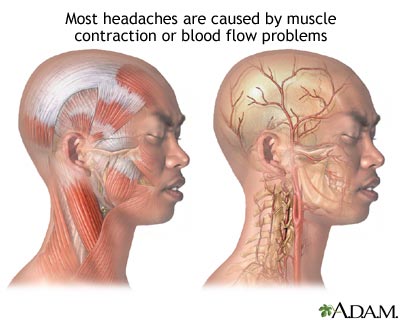How are secondary headaches diagnosed?
If there is time, the diagnosis of secondary headache begins with a complete patient history followed by a physical examination and laboratory and radiology tests as appropriate.
However, some patients present in crisis with a decreased level of consciousness or unstable vital signs. In these situations, the health care practitioner may decide to treat a specific cause without waiting for tests to confirm the diagnosis.
For example, a patient with headache,fever, stiff neck, and confusion may have symptoms that suggest meningitis. Since meningitis can be rapidly fatal, antibiotic therapy may be started before blood tests and a lumbar puncture are performed to confirm the diagnosis.
What are the exams and tests for secondary headaches?
The patient history and physical examination provide the initial direction for determining the cause of secondary headaches. Therefore, it is extremely important that patients with severe headaches seek medical care and give their health care practitioner an opportunity to assess their condition. Tests that may be useful in making the diagnosis of the underlying disease causing headaches include:
- blood tests,
- computerized tomography (CT Scan),
- magnetic resonance imaging (MRI) scans of the head, and
- lumbar puncture.
Specific tests will depend upon what potential issues the health care practitioner and patient want to address.
Blood tests
Blood tests provide helpful information in association with the history and physical examination in pursuing a diagnosis. For example, an infection or inflammation in the body may cause a rise in the white blood cell count, the erythrocytesedimentation rate (ESR) or C-reactive protein (CRP). These two tests are very non-specific, that is, they may be abnormal with any infection or inflammation, and abnormalities do not point to a specific diagnosis of the cause of the infection or inflammation.
Blood tests can also assess electrolyte disturbances, and a variety of organ functions like liver, kidney, and thyroid.
Computerized tomography of the head
Computerized tomography (CT scan) is able to detect bleeding, swelling, andtumors. It can also show evidence of previous stroke. With intravenous contrast injection, it can also be used to look at the arteries of the brain.
Magnetic resonance imaging (MRI) of the head
MRI is able to better look at the anatomy of the brain, meninges (the layers that cover the brain and the spinal cord). While it is more precise, the time to perform the scan is significantly longer than for computerized tomography. This type of scan is not available at all hospitals. Moreover, it takes much longer to perform, requires the patient to cooperate by holding still, and requires that the patient have no metal in their body (for example, a heart pacemaker or metal foreign objects in the eye).
Lumbar puncture
Cerebro-spinal fluid, the fluid that surrounds the brain and spinal cord, can be obtained with a needle that is inserted into the spine in the lower back. Examination of the fluid can reveal infection (such as meningitis due to bacteria, a virus, or tuberculosis) or blood from hemorrhage. In almost all cases, computerized tomography is done prior to lumbar puncture to make certain there is no bleeding, swelling, or tumor in the brain. Pressure within the space can be measured when the lumbar puncture needle is inserted. Elevated pressures may make the diagnosis of idiopathic intracranial hypertension in combination with the appropriate circumstances.
When should I seek medical care for a headache?
A patient should seek medical care if their headache is:
- The "worst headache of your life." This is the wording often used in textbooks as a cue for medical practitioners to consider the diagnosis of a subarachnoid hemorrhage due to a ruptured cerebral aneurysm. The amount of pain will often be taken in context with the appearance of the patient and other associated signs and symptoms.
- Different than your usual headaches
- Starts suddenly or is aggravated by exertion, coughing, bending over, or sexual activity
- Associated with persistent nausea and vomiting
- Associated with fever or stiff neck
- Associated with seizures
- Associated with recent head trauma or a fall
- Associated with changes in vision, speech, or behavior
- Associated with weakness or change in sensation
- Not responding to treatment and is getting worse
- Requires more than the recommended dose of over-the-counter medications for pain
- Disabling and interfering with work and quality of life
Headache At A Glance
- The head is one of the most common sites of pain in the body.
- The most common types of headache can be classified as 1) primary, 2) secondary, and 3) cranial neuralgias, facial pain, and other headaches.
- The most common types of primary headaches are 1) tension, 2) migraine, and 3) cluster.
- Tension headaches are the most common type of primary headache and usually are treated with over-the-counter medications for pain
- Secondary headaches are a symptom of an injury or an underlying illness.
- Patients should seek medical care for new onset headaches, fever, stiff neck, change in behavior, vomiting, weakness or change in sensation.
